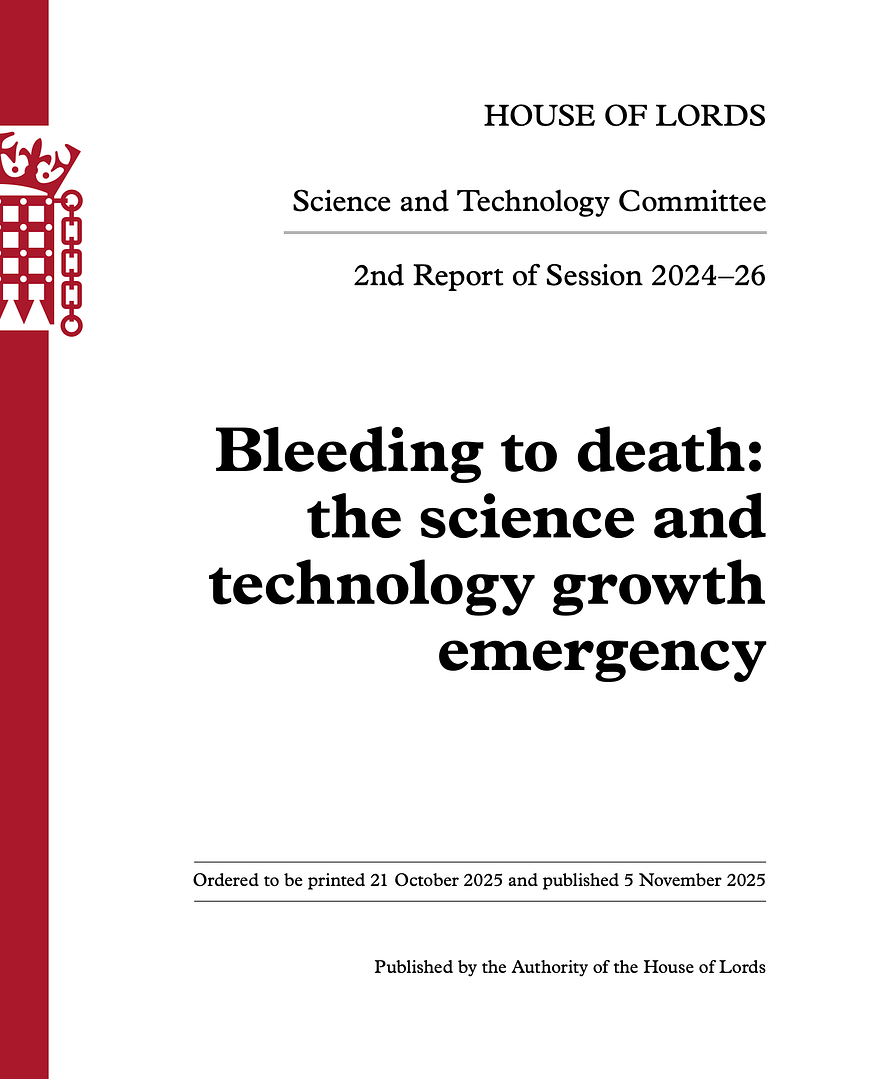From Headlines to Hardwiring: Why the UK’s Innovation Engine Is Misfiring
The ranking drop is the symptom, not the disease. Yes, the UK slipped from #2 (2015) to #6 (2025) on WIPO’s Global Innovation Index; in 2015 we were trumpeting world-leader status, today we’re explaining the slide. The causes are structural and fixable — but only if we stop treating “innovation” as a press line and start rebuilding the plumbing.

What’s actually going wrong (beneath the league table)
1) Decision-makers who don’t speak “systems”
Roughly 173 of 650 MPs have a STEMM background; the Civil Service’s Government Science & Engineering profession is ~10,000 people out of ~543,000 staff — about 2% of the workforce. In a STEM-driven economy, that’s a thin layer of technical judgment at the point of policy. It shows up in programme design, vendor selection, safety cases, and how we assess risk.
2) Incentives built for papers, not plants
Universities are world-class at discovery, but the incentive stack (REF, KEF) still rewards outputs and narratives more than repeatable industrialisation. Government’s own documents acknowledge the emphasis on publication and environment; diffusion into firms — the boring, GDP-generating bit — lags.
3) We underweight the “old” STEM that powers the “new”
Everyone references “digital.” Fine. But the modern economy is a web of semiconductors, chemicals, energy, and space-based PNT:
- Semiconductors: the 2021 chip shock wiped ~100,000 units off UK car output; globally it cost automakers ~$210bn that year. The UK now has a £1bn semiconductor strategy — good — but delivery must prioritise compound semis, power electronics and supply-chain resilience.
- Chemicals: the UK chemical sector generates ~£22bn GVA and sits upstream of almost every manufactured product (the global rule-of-thumb: >90% of manufactured goods rely on chemistry). Ignore this and you strangle productivity from materials to medicines.
- Space/PNT: strip out satellite timing/GPS and you hobble telecoms, finance, logistics, and power networks. The UK government now estimates ~18% of GDP relies on satellite services; a 5-day GNSS outage could cost ~£5.2bn. That’s systemic risk, not trivia.
- Energy systems: engineering hiring is already the constraint; ~19% of UK jobs are in engineering and tech occupations, with “green engineering” demand surging. Skills aren’t a “nice to have”; they’re throughput.
4) Procurement and payments that privilege incumbents
SMEs are 99%+ of firms, 60% of employment and roughly half of turnover — yet public procurement often selects for balance sheet over capability, and late payment bleeds working capital. The Procurement Act’s 30-day payment rule (now applying through supply chains) helps, but enforcement and board-level scrutiny of payment practices must bite.
5) We keep asking the same people
Bringing in FTSE grandees and celebrity technologists is fine for optics; it’s weak for delivery. Continuity is poor (e.g., Poppy Gustafsson’s <1-year stint as Investment Minister), and the policy feedback loop rarely includes the operators who actually install kit, pass audits, and make payroll.
As I argue in Born to Disrupt, leadership isn’t about doing everything yourself — it’s about hiring against your gaps and giving those people real authority. We haven’t done that at national scale.
Don’t just “consult business.” Put entrepreneurs into the wiring.
A modern innovation state needs operators in the room — founders and builders from micro-firms to mid-caps, supply-chain specialists, systems engineers — not just FTSE NEDs and tech celebrities.
What to fix (and how)
A) Institutional fixes that change decisions
- Technical Review Boards for big programmes: For any project >£100m, require a published red-team review by a chief engineer, chief scientist, and commercial operator with recent FOAK/scale-up experience. Decision logs must show how recommendations changed the plan.
- Departmental Chief Engineers with veto power: Appoint a permanent Chief Engineer/CTO in every major department with authority to block safety-critical and infrastructure decisions that don’t meet technical and delivery standards. Grow the GSE cadre accordingly.
- Operator-in-Residence schemes: 6–12 month secondments of SME founders, scale-up COOs, plant managers and safety leads into policy teams (and vice versa) — at hundreds per year, not tens.
- Standards seats for SMEs: Fund day-rates so smaller firms can sit on BSI/IEC/ISO committees in power electronics, hydrogen systems, industrial cyber, and pharma QA. Standards are market access; pay to play.
B) Get the STEM economy into the bloodstream (beyond “digital”)
- Compound semiconductor & power-electronics sprint: Focus South Wales and Midlands clusters with de-risked FOAK: public co-funding for pilot lines and guaranteed offtake for components in grid hardware, EV drivetrains and aerospace. Aim for export-class products within 24–36 months.
- Chemicals as strategic infrastructure: Plan at cluster level (Tees, Humber, Grangemouth) for heat, hydrogen, CO2 handling and permitting. Link Innovate UK support to process validation, certification and customer offtake, not just TRL badges.
- PNT resilience as an industrial mission: Fund GNSS-independent timing (eLoran, fibre, space-based alternatives) and procure PNT holdover across finance, power and telecoms to reduce national risk and create a market for UK RF/timing SMEs.
C) Let smaller firms compete — on delivery, not on balance sheet
- Open, staged procurement for FOAK: Expand SBRI-style phased contracts (spec → prototype → FOAK → offtake) with explicit scoring for operational readiness and conformance testing. Publish post-mortems so learning compounds across government.
- Enforce prompt payment publicly: Require primes to publish median supplier days-to-pay and link compliance to contract renewal; regulators to spot-check and fine. Make the Procurement Act’s 30-day rule bite through the chain.
- Catapult access priced for SMEs: Cap day-rates for standard services; publish queue times; measure outcomes (jobs, revenue, exports) not just engagements.
D) Raise adoption, not just invention
- Technology Adoption Vouchers for the “long tail”: Co-fund SME adoption of industrial software, robotics, metrology and power systems audited by accredited implementers.
- Measure what we depend on: Track exposure to chip, chemicals, PNT and grid bottlenecks in the National Risk Register and align capital allowances and fast-track permitting with de-bottlenecking.
If you’re fixing diffusion and delivery at board level, here’s how I work with Chairs and CEOs: Board advisory & operator-led strategy.
Why involve entrepreneurs from all levels?
Because scale happens in layers. FTSE boardrooms don’t run the pilot lines, weld the hydrogen pipework, certify the cleanrooms, or pass MHRA audits. SMEs employ ~60% of workers and generate ~half of turnover; they’re where adoption either stalls or accelerates. If they can’t get paid on time, get a grid connection, or get on a framework, your strategy is narrative, not economics. And remember: the “digital economy” rides on non-digital foundations — chips, chemicals, energy, and satellites. Most firms use computers; far fewer understand the supply chains and physics inside the box. That’s a policy problem, not a pedagogical one.
The bottom line
We fell to #6 because we’re starved of technical judgment, we under-reward industrialisation, and we make it too hard for the firms who actually build things to sell to their own government. Put operators into the wiring, move money toward adoption and FOAK, enforce payment discipline, and treat foundational STEM as strategic infrastructure. Do that, and the rankings will follow the real economy — back up.
#innovation #UKEconomy #STEM #IndustrialStrategy #Semiconductors #Chemicals #Space #Energy #SMEs #Procurement #BornToDisrupt
Selected sources
- WIPO Global Innovation Index
- Business Matters: UK slips global innovation rankings
- GOV.UK: UK ranked as world leader in innovation
- CaSE — Campaign for Science and Engineering
- ONS — Technology adoption & digital economy
- SBRI — Small Business Research Initiative
FAQ
Why did the UK fall in the Global Innovation Index in 2025?
A thin layer of technical leadership in policymaking, weak diffusion from labs into firms, and procurement/payment practices that favour incumbents over operators.
What’s the fastest way to raise UK innovation productivity?
Link funding to first-of-a-kind (FOAK) deployments and customer offtake, enforce 30-day payments through supply chains, and embed engineers/operators in major programme decisions.
How do SMEs fit into UK industrial strategy?
SMEs drive adoption and supply chains. Let smaller firms compete on delivery (SBRI-style stages, standards access), not just on balance sheet.


Good, clear blueprint for making needed, fundamental, systemic improvements.
Nice work, Tim.